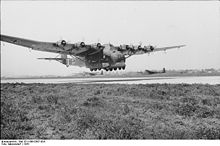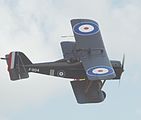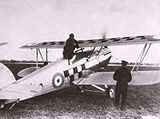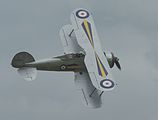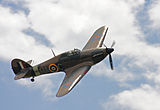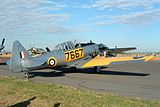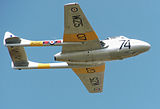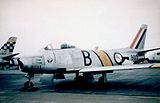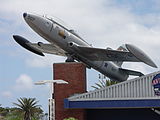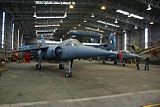- 1 Squadron SAAF
-
1 Squadron 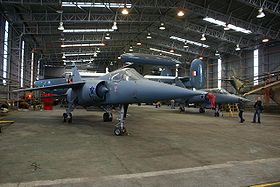
Two retired Mirage F1's (CZ's and not AZ's as flown by 1 Sqn)at Ysterplaat AFB MuseumActive February 1920 to 25 November 1997[1] Country 
 South Africa
South AfricaBranch South African Air Force Role Fighter / Attack Squadron Garrison/HQ AFB Hoedspruit when disbanded. Nickname The Billy Boys[Note 1] Motto Prima (First)[1] Insignia Squadron Badge 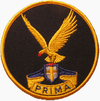
Squadron Identification Code AX 1939-1945 1 Squadron SAAF was an air force squadron of the South African Air Force and was formed at Air Force Station Swartkop in February 1920, equipped with De Havilland DH.9's donated to South Africa by Britain. On 31 August 1939 the squadron was re-designated as 1 Bomber/Fighter Squadron and this was then changed to 11 (Bomber) Squadron in December 1939. The squadron was resurrected in February 1940 by the renumbering of 6 Squadron, equipped with four Hurricane Mk 1's and six Furies.
1 Squadron saw active service in East Africa in 1940, the Western Desert, Malta, Sicily and ended their war service in Italy in 1945. In 1950 the squadron's Spitfires were replaced with Vampires and these in turn were replaced by Sabre Mk6's in 1956. In 1976 the squadron received Mirage F1AZ attack aircraft and it was disbanded when the F1AZ's were retired on 25 November 1997.[1]
Contents
History
Establishment
There had been no official squadron designations in the South African Air Force (SAAF) from its inception in 1920[2] until the early 1938 when 1 and 2 Transvaal Air Squadrons were formed as training units based at Waterkloof Air Station which had been opened earlier that year.[3] Each squadron comprised 18 aircraft, divided into 3 flights each, plus a headquarters or administrative flight per squadron. Each flight was structured to form the working nucleus of a squadron. A flight of SE5's was to be the cadre of a fighting/ground strafing squadron; Avro 504Ks of a training and artillery spotter squadron, and DH9s were to form the cadre of a long-distance communication, photographic, bombing, and reconnaissance squadron.[4]
World War II
On 31 August 1939, 1 Transvaal Air Squadron was re-designated as 1 (Fighter-Bomber) Squadron, and the original aircraft were replaced with Hawker Hartebeest.[4] It took until May 1940 for the squadron to be trained and brought up to strength, by when it had been equipped with four Hurricanes and six Furies and was officially titled "1 (Fighter) Squadron," commanded by Maj. N.G. Niblock-Stuart. The Squadron was the first SAAF squadron to deploy in support of the Allied war effort, when a group of pilots and support staff were ferried to Egypt on 13 May 1940 by 50 Squadron.[5] Once they had arrived in Egypt, they were equipped with 18 Gloster Gladiators.[6] At the same time, the squadrons Hurricanes were ferried north from Pretoria on 22 and 24 May, accompanied by a Ju86[Note 2] carrying the maintenance crews and arrived in Nairobi at the end of May.[5] The Squadron's Fury aircraft were flown from Pretoria to Durban for crating and were then shipped to Mombasa on SS Takliwa, embarking on 26 May and arriving in East Africa on 1 June 1940 where the Fury's were un-crated and re-assembled.[7] By early June the pilots from Egypt had married up with their aircraft in East Africa and were declared operational.[6]
East Africa
1 Sqn deployed on their first operational mission in an attack on the Italian air base at Yavello in Abyssinia on 19 June 1940. The task of the four Hurricanes was to escort three Ju86 bombers from 12 Sqn in the attack on the airfield. The attack destroyed airport infrastructure as well as six Caproni Ca 133's on the ground but during the bombing run, a formation of Fiat CR32's surprised the attackers, severely damaging one of the Ju86's and shooting down one of the Hurricanes[Note 3] The CR32's were subsequently driven off by the three remaining Hurricanes, with one CR32 being shot down.[8]
The Squadrons Hurricanes, Gladiators and Hartbees aircraft continued to provide fighter cover but by late 1940 the Hartbees aircraft were proving to no longer be a match for the Italian CR42's and one flight consisting of Hartbees and Gladiators was split off from the squadron to form the nucleus of 2 Fighter Bomber Squadron.[9] The Squadron then continued operating with the remaining Gladiators and Hurricanes from airfields in Abyssinia and Sudan until the fall of Addis Ababa on 5 April 1941. Although the East African campaign continued until November 1941, the absence of Italian fighters permitted the squadron to be moved to the Middle East on 8 April 1941.[10]
Western Desert
The Squadron arrived in April 1941 and scored its first kill on 16 May when Lt. Talbot shot down a Ju 87. The first large scale deployment was in support of Operation Brevity and later in support of Operation Battleaxe when Lt. Talbot - the squadrons highest scoring ace with 10 kills at that stage, was shot down and killed.[11] By this stage, the squadron was only flying Hurricanes. During Operation Crusader the squadron forced down a German Bf109F, capturing it intact - for which they were congratulated by Air Chief Marshall Tedder for capturing the first of this type of aircraft.[12]
On 3 July 1942, the squadron was intercepting a German raid on the Alamein area while 274 Sqn (RAF) was providing them with top cover. The formation came across 15 Ju87's escorted by 7 Bf109's; 274 Sqn attacked the Bf109's whilst 1 Sqn went after the Ju87's. In what was later to become known as the "1 Squadron Stuka Party" the squadron destroyed 14 Ju87's, damaged two and shot down one of the Bf109's for no loss of own aircraft in a forty-five minute engagement.[13]
During the second Battle of El Alamein, the Squadron was tasked with protecting the allied armour in their advance across the start line during the break-out phase, where Squadron Hurricanes destroyed a number of Ju87 Stukas during this phase of the battle.[14] After the Battle of Alamein, the squadron received Spitfires as replacements for their Hawker Hurricanes.
During April 1943, German transport aircraft were freighting supplies to the beleaguered Africa Korps in Tunisia after Allied air and sea interdiction had stopped most of their ship borne supplies coming from Italy. On the 22nd, the Squadron Spitfires joined by Kittyhawks from SAAF 2, 4 and 5 Squadrons intercepted 21 huge Me323's attempting to bring in fuel (each aircraft carried 10 tons of fuel) to Tunisia. They destroyed 16 Me323's and two of their fighter escorts (one MC.202 and one Re.2001). After this successful intercept, Goering forbade all transport flights to Africa. The decision was overturned two days later after protests from Kesselring, on condition that all future flights were made by night.[15]
Italy
By July 1943, 1 Sqn had ceased operations in North Africa and were then tasked with patrolling the beaches where the landings for the invasion of Sicily were to take place. After the successful landings of Operation Husky and the subsequent exploitation, the Squadron moved to Sicily on 14 July. After 38 days in Sicily, the squadron again provided cover for the British landings in Italy on 3 September 1943[16] to be followed by them providing fighter cover at the Anzio landings on 22 January 1944.[17] The Squadron then moved to Italy and supported the assault on Rome, claiming 16 enemy aircraft destroyed during this battle.[18] 1 Squadron remained in Italy for the rest of the war operating as a fighter squadron but also flying ground attack sorties towards the end of the Italian campaign. In June 1945 the squadron began to convert to the North American Mustangs, but by July 1945, when the squadron's personnel started to return to South Africa, only a few Mustangs had been delivered.[19]
1950's and 1960's
After the end of the war, the number of SAAF aircraft were greatly reduced, many being scrapped or sold at nominal prices. By June 1946, the Squadron was assigned to 7 Wing (SAAF) based at Waterkloof air Station, flying Harvards but still retaining the Spitfires.[20] In 1947 the concept of the Active citizen Force was introduced whereby permanent force pilots would fly the squadron aircraft in the week and citizen force pilot officers would pilot the same Harvards and Spitfires over the weekends. Because of the Citizen Force association with the squadron, its name was changed to 1 "City of Pretoria" Squadron.[21]
By 1954 all of the Squadron's Spitfires were retired and replaced by Sabre Mk6's in 1956. Additional new aircraft types were procured and by 1957 the Squadron had 16 Sabres, 12 Vampires and 12 Harvards on strength.[22]
Border War
Disbandment
Deployment and Aircraft
Bases and areas of operation
The Squadron was deployed from the following bases / operated in the following arenas:
Period From Period To Base Area of Operations February 1920 1936 AFS Swartkop[1] South Africa 1936 May 1940 AFS Waterkloof[1] South Africa June 1940 8 April 1941 Kenya, Abyssinia, Sudan (Azzoza and Port Sudan) and Eritrea (Tessebei)[19] East Africa 8 April 1941 May 1943 Various bases and forward airfields in Egypt, Libya and Tunisia Western Desert[23] June 1943 14 July 1943 Luga and Takali (Malta) Malta[24] 14 July 1943 September 1943 Pachino (Sicliy) Sicily[24] September 1943 August 1945 Various bases and forward airfields in Italy (Isola, Cassano, Scanzano, Gioia del Colle, Palata, Trigno, Sinello, Marcigliano, Orvieto, Foiana, Rimini, Bellaria, Forli, Ravenna and finally Lavariano) Italy[19] August 1945 June 1947 AFB Swartkop[1] South Africa June 1947 1967 AFB Waterkloof[1] South Africa 1967 1975 AFB Pietersburg[1] South Africa, South West Africa (Namibia), Angola 1975 14 January 1981 AFB Waterkloof[1] South Africa, South West Africa (Namibia), Angola 14 January 1981 25 November 1997 AFB Hoedspruit[1] South Africa, South West Africa (Namibia), Angola Aircraft
Aircraft flown by 1 Squadron
Note: Aircraft type photographs may not necessarily represent aircraft of the same mark or actual aircraft belonging to the Squadron.Airco DH.9Royal Aircraft Factory S.E.5Hawker HartbeestHawker FuryGloster GladiatorHawker HurricaneSupermarine Spitfire Mk. VCNorth American T-6 Texan (Harvard)Supermarine Spitfire Mk IXDe Havilland Vampire FB-52Canadair CL-13B Sabre Mk.6Atlas Impala Mk IMirage F1AZSee also
References
Bibliography
- Agar-Hamilton, J.A.I.; Turner, L.F.C. (1952). Crisis in the Desert: May – July 1942. Vol II (1st ed.). Cape Town: Oxford University Press.
- Becker, Dave (1991). On Wings of Eagles: South Africa's Military Aviation History. Durban: Walker-Ramus. ISBN 0-947478-47-7.
- Brown, James Ambrose (1970). A Gathering of Eagles: South African Forces World War II: Volume II. Cape Town: Purnell.
- Brown, James Ambrose (1974). Eagles Strike: South African Forces World War II: Volume IV. Cape Town: Purnell. ISBN 360001963.
- Brown, James Ambrose (1990). The War of a Hundred Days:Springboks in Somalia and Abyssinia 1940-1941. Rivonia: Ashanti. ISBN 1874800103.
- McLean, Steven (2005). Squadrons of the South African Air Force and their aircraft 1920-2005,. Interpak Books. ISBN 0-9584929-4-8.
- Playfair, Major-General I.S.O.; with Stitt, Commander G.M.S; Molony, Brigadier C.J.C. & Toomer, Air Vice-Marshall S.E. (2004) [1st. pub. HMSO:1954]. Butler, J.R.M. ed. Mediterranean and Middle East Volume I: The Early Successes Against Italy (to May 1941). History of the Second World War, United Kingdom Military Series. Uckfield, UK: Naval & Military Press. ISBN 1-845740-65-3.
- Playfair, Major-General I.S.O.; Molony, Brigadier C.J.C.; with Flynn, Captain F.C. (R.N.) & Gleave, Group Captain T.P. (2004) [1st. pub. HMSO:1966]. Butler, Sir James. ed. The Mediterranean and Middle East, Volume IV: The Destruction of the Axis Forces in Africa. History of the Second World War, United Kingdom Military Series. Uckfield, UK: Naval & Military Press. ISBN 1-845740-68-8.
- Shores, Christopher, F. (1973). Pictorial History of the Mediterranean Air War: Vol II: RAF 1943-45. London: Ian Allan. ISBN 0711004331.
Notes
- Footnotes
- ^ During the World War II fighting in the Western Desert in 1941 (while renumbered as 6 Squadron) they acquired their nickname "The Billy Boys" because whenever successful in combat, the South African pilots would shout "Jou Bielie!" over the radio (roughly translated into British English as "You clever chap!" and into American English as "You Hoss!").
- ^ These Ju86's had been purchased from Germany as passenger aircraft for South African Airways. At the outbreak of war, they were transferred to the SAAF and modified to permit them to be used as bombers by the addition of external bomb racks. (Brown (1990) p.54)
- ^ 2nd Lt B.L. Griffiths, who was to be the first operational casualty of the Squadron.
- Citations
- ^ a b c d e f g h i j "South African Air Force (Unofficial)". 1 Squadron. http://www.saairforce.co.za/the-airforce/squadrons/19/1-squadron.
- ^ Tidy, D.P. Major. "South African Military History Society". They Mounted up as Eagles: A brief tribute to the South African Air Force. http://www.samilitaryhistory.org/vol056dt.html.
- ^ Becker (1991) p.49
- ^ a b Brown (1970) pp.21-22
- ^ a b Brown (1970) pp.33-34
- ^ a b Becker (1991) p.67
- ^ "Hakans Aviation Page". South African Air Force use of the Hawker Fury during the Second World War. http://surfcity.kund.dalnet.se/fury_southafrica.htm.
- ^ Brown, (1990) p.54
- ^ Becker (1991) p.71
- ^ Becker (1991) p.73
- ^ Becker (1991) p.81
- ^ Becker (1991) p.85
- ^ Becker (1991) pp.89-91
- ^ Playfair Vol.IV, (2004) p.68
- ^ Playfair Vol IV, (2004) p.416
- ^ Becker (1991) p.125
- ^ Becker (1991) p.129
- ^ Becker (1991) p.137
- ^ a b c "History of War". No. 1 Squadron (SAAF): Second World War. http://www.historyofwar.org/air/units/SAAF/1_wwII.html.
- ^ Becker (1991) p.157
- ^ Becker (1991) p.163
- ^ Becker (1991) p.179
- ^ Brown., (1974) p.381-382
- ^ a b McLean, (2005)
External links
- 1 Squadron SAAF on Facebook

- "1 Squadron Mirage F1 AZ SAAF South African Air Force". http://www.youtube.com/watch?v=aVnwXK2yn-g. Retrieved 1 September 2011.

Active Squadrons 
Training and Development Units 68 Air School · 80 Air Navigation School · 85 Combat Flying School · 87 Helicopter Flying School · Central Flying School · Test Flight and Development Centre · South African Air Force CollegeReserve Squadrons 101 · 102 · 104 · 105 · 106 · 107 · 108 · 110 · 111Disbanded Squadrons Bases AFB Bloemspruit · AFB Durban · AFB Hoedspruit · AFB Langebaanweg · AFB Makhado · AFB Overberg · AFB Swartkop · AFB Waterkloof · AFB YsterplaatRelated Categories:- Squadrons of the South African Air Force
- Military units and formations established in 1920
- Military units and formations disestablished in 1997
- 1920 in South Africa
Wikimedia Foundation. 2010.

